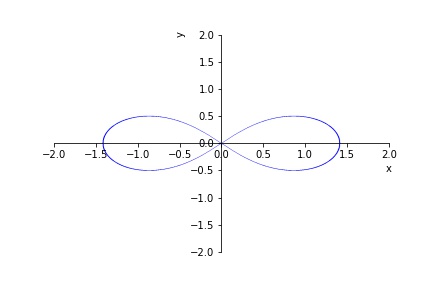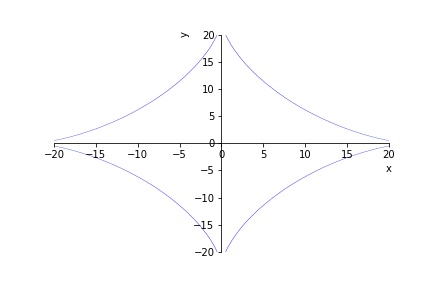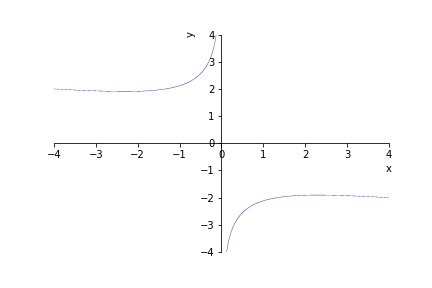Implicit Differentiation Questions
Find \({dy\over dx}\) when \(x\) and \(y\) satisfy:
- \(e^{xy} = e^{4y} - e^{5x}\)
- \(\cos(xy)=\sin(x-y)\)
- \(y\tan(x+y) = 4\)
- \(e^{\cos(x)} + e^{\sin(y)} = {1\over
4}\)
- \(e^{xy} + \ln(xy) = \text{cosec}(x) +
4\)
Find \({dy\over dx}\) when \(x\) and \(y\) satisfy:
- \(e^{xy} = e^{4y} - e^{5x}\)
- \(\cos(xy)=\sin(x-y)\)
- \(y\tan(x+y) = 4\)
- \(e^{\cos(x)} + e^{\sin(y)} = {1\over 4}\)
- \(e^{xy} + \ln(xy) = \text{cosec}(x) + 4\)
Solutions We apply the derivative operator \({d\over dx}\) to each equation and rearrange to get \({dy\over dx} = \dots\). The step-by-step solutions for 1. is provided, and the final solutions to the others only being provided.
The left-hand side is equal to \[{d\over dx}e^{xy} = e^{xy}\cdot {d\over dx}(xy) = e^{xy}(y+ x{dy\over dx}) = ye^{xy} + xe^{xy} {dy\over dx}.\] And the right-hand side is equal to \[{d \over dx}(e^{4y} - e^{5x}) = e^{4y}{d\over dx}(4y) - e^{5x}{d\over dx}(5x) = 4e^{4y}{dy\over dx} - 5e^{5x}.\] So we have that: \[ ye^{xy} + xe^{xy}{dy\over dx} = 4e^{4y}{dy\over dx} - 5e^{5x} \] which rearranges to: \[ xe^{xy}{dy\over dx} - 4e^{4y}{dy\over dx} = -ye^{xy} -5 e^{5x}. \] So we have that \[ (xe^{xy} - 4e^{4y}) {dy\over dx} = -ye^{xy} - 5e^{5x} \] and finally so: \[ {dy\over dx} = \frac{-ye^{xy} - 5e^{5x}}{xe^{xy} - 4e^{4y}} = \frac{ye^{xy} + 5e^{5x}}{ 4e^{4y}- xe^{xy}} \]
\[ {dy\over dx} = \frac{\cos(x-y) + y\sin(xy)}{\cos(x-y) - x\sin(xy)} \]
\[ {dy\over dx} =\frac{-y\sec^2(x+y)}{\tan(x+y) +y\sec^2(x+y)} \]
\[{dy\over dx} = \frac{\sin(x)e^{\cos(x)}}{\cos(y)e^{\sin(y)}}\]
\[{dy\over dx} = -1 - \frac{xy \text{cosec}(x)\cot(x)}{xye^{xy} + 1}\]
Find all the points \((x,y)\) on the
graph \((x^2+y^2)^2 = 2x^2 - 2y^2\)
where \(y’ = 0\).


Step 1: Find an expression for \({dy\over dx}\) by taking the \(x\) derivative of the equation: \[\begin{align} {d\over dx} (x^2+y^2)^2 &= {d\over dx}(2x^2- 2y^2) \\ 2(x^2 + y^2) {d\over dx}(x^2+y^2)&=4x - 4y {dy\over dx} \\ 2(x^2 + y^2)(2x +2y{dy\over dx})&=4x - 4y {dy\over dx} \\ 4y(x^2 + y^2){dy\over dx}+ 4y{dy\over dx}&=4x-4x(x^2 + y^2)\\ {dy\over dx}&= {x(1-(x^2 + y^2))\over y(1+(x^2 + y^2))} \end{align}\]
Step 2: Solve \({dy\over dx}=0\). This can occur when \(x = 0\) and \(y\neq 0\), so let’s investigate possible solutions of this type. Substituting this into the equation for the curve, we have that \(y^4 = -2y^2\), which if \(y\neq 0\), leaves \(y^2 =-2\), which has no real solutions. So we are left with the requirement that \(1-(x^2 + y^2)=0\). So we have that the equation of the curve becomes \(1 = 2x^2 - 2y^2\). We can eliminate either \(x\) or \(y\) using the equation \(1 = x^2 + y^2\) - I will choose to eliminate \(x^2\). Then we have that \(x^2 = 1-y^2\). So \[1=2x^2 -2y^2 = 2(1-y^2)-2y^2 = 2-4y^2.\] So we have that \(4y^2 = 1\), which gives us solutions of \(y = \pm {1\over 2}\). Thus we have that \[x^2 = 1-(\pm {1\over 2})^2 = 1-{1\over 4} = {3\over 4}.\] Giving \(x = \pm {\sqrt{3}\over 2}\). So the final solutions are: \[(x,y) = ({\sqrt{3}\over 2},{1\over 2}), \ (-{\sqrt{3}\over 2},{1\over 2}),\ ({\sqrt{3}\over 2},-{1\over 2}),\ (-{\sqrt{3}\over 2},-{1\over 2}) \]
Find the equation of the tangent line to the curve: \(y^2 e^{2x}=3y + x^2\) at the point \((0,3)\)
Find the equation of the tangent line to the curve: \(y^2 e^{2x}=3y + x^2\) at the point \((0,3)\)
- Step 1: Find an expression for \({dy\over dx}\) in terms of \(x\) and \(y\). We do this by taking the \(x\)-derivative of the equation of the curve: \[ \begin{align} {d\over dx}(y^2 e^{2x}) &= {d\over dx}(3y + x^2)\\ 2y{dy\over dx}e^{2x} + 2y^2e^{2x}&=3{dy\over dx} + 2x. \end{align} \] After rearranging we have that \[ \begin{align} (2ye^{2x} - 3){dy\over dx} &= 2x - 2y^2 e^{2x}\\ {dy\over dx}&= \frac{2x - 2y^2 e^{2x}}{(2ye^{2x} - 3)}. \end{align} \] Thus we have that \({dy\over dx}\) at the point \((x,y) = (0,3)\) is equal to \({dy\over dx} = -{18\over 3} = -6\). So the tangent line would have equation \(y = -6x + c\), and intersects the original curve at the point \((0,3)\), thus \(3 = -6\cdot 0 + c \implies c = 3\). Thus the tangent line has equation \(y = -6x +3\).
- Show that \({dy\over dx}\) for the
curve given by \((x+y)(x^2 - xy +
y^2)=1\) is:
\[
{dy\over dx} = - {x^2 \over y^2}
\] whenever \(y\neq 0\)
- Find the equation of the normal when \(x=0\).
- Show that \({dy\over dx}\) for the curve given by \((x+y)(x^2 - xy + y^2)=1\) is:
\[ {dy\over dx} = - {x^2 \over y^2} \] whenever \(y\neq 0\)
- Find the equation of the normal when \(x=0\).
To simplify the calculation we expand the brackets to get that \[ \begin{align} (x+y)(x^2-xy+y^2) &= x^3 - x^2y + xy^2 + yx^2 - xy^2 + y^3 \\ &= x^3 + y^2. \end{align} \] So the equation is just \(x^3 + y^3 = 1\), we then take the \(x\) derivative to give: \[ {d\over dx}(x^3 + y^3) = 3x^2 + 3y^2 {dy\over dx} = 0, \] which rearranges to the answer.
At \(x=0\), we have that \(y^3 = 1\), which has real solution \(y=1\), so the tangent line at \((x,y)=(0,1)\) is given by \(y = 0\cdot x + c\) as \({dy\over dx} = -\frac{0}{1} = 0\) at \((x,y)=(0,1)\). Thus the tangent line is a constant line \(y = 1\). The normal equationIf this is confusing to you, think about the graph \(y=1\) and then construct a perpendicular line that goes through the point \((0,1)\)
is therefore just \(x=0\).
Find the points \((x,y)\) on the graph
\(x^{2/3} + y^{2/3} =8\), where \(y’ = 1\).


Taking the \(x\) derivative of the
equation we have that: \[ {2\over 3}x^{-1/3}
+ {2\over 3}y^{-1 /3}{dy\over dx} = 0.
\] Which rearranges to: \[
{dy\over dx} = - {x^{-1/3}\over y^{-1/3}} = - \frac{y^{1/3}}{x^{1/3}}.
\] This equals \(1\), when \(y^{1 /3} = - x^{1/3}\), and by cubing this
equation we have that \(y = - x\). So
we need to simultaneously satisfy the equations \(x^{2/3} + y^{2/3} =8\) and \(y = -x\). Notice that \((-x)^{2/3} = ((-x)^{1/3})^2 =
((-1)^{1/3}x^{1/3})^2\), assuming we are only interested in the
realThere are also complex numbers which are the cube root
of -1, but we will ignore those
solutions to this equation we have that \((-1)^2 x^{2/3}=x^{2/3}\). So we have that
\(2x^{2/3} = 8\), thus \(x^2= 4^{3} = 64\) and thus \(x=\pm 8\). So the points of the graph are
\((x,y) = (8,-8),\ (-8,8)\).

- The curve C is described by the equation \(3x^2 + 2xy^3 + 16 = 0\). Show that the
normal to C at the point \(x=-4\) is
parallel to the normal to C at \(x=4\).
- Find the distance between the y-intercepts of these two
normals.

- The curve C is described by the equation \(3x^2 + 2xy^3 + 16 = 0\). Show that the normal to C at the point \(x=-4\) is parallel to the normal to C at \(x=4\).
- Find the distance between the y-intercepts of these two normals.
-
When \(x=+ 4\) the equation simplifies to \(y^3= -8\), with \(y=-2\) its solution. And when \(x=-4\), we have that \(y^3 = 8\) and thus \(y=2\).
The normal line to these points are then found by first finding the tangent line. To do this we need an expression for the gradient, \(dy \over dx\), which we get by taking the \(x\)-derivative of the equation: \[\begin{align} 6x + 2y^3 + 6xy{dy\over dx} = 0\\ {dy\over dx} = {-3x -y^3 \over 3xy} \end{align} \]
Thus the gradient at \((x,y) = (4,-2)\) is equal to \[{dy \over dx} = {-12 + 8 \over -24 }=-{4\over 24} = - {1\over 6}.\]
And the gradient at \((x,y) =(-4,2)\) is equal to \[{dy\over dx} = {12 - 8 \over -24} = - {1\over 6}.\] As the tangents have the same gradient, the normal lines at these points will also have the same gradient, as the normal has the negative reciprocal gradient as the tangent, i.e. \(m= 6\) for both normals.
The equations of the normals are \(y = 6x+c\), where \(c\) is the \(y\)-intercept. The normal to the point \((x,y) = (4,-2)\) needs to have \(c = y-6x = -2 - 6\cdot 4 = -26\). The normal to the point \((x,y) = (-4,2)\) needs to have \(c = 2+6\cdot 4 = 26\). So the distance between the \(y\)-intercepts is $52
Find the stationary points and determine their nature* for the curve
with equation \(y^2 = 3x^2 -2xy +
3\)
*are they maxima, minima or indeterminate.
Find the stationary points and determine their nature* for the curve with equation \(y^2 = 3x^2 -2xy + 3\)
*are they maxima, minima or indeterminate.
To find stationary points, we need to find the points where \({dy\over dx}=0\). So we take the \(x\)-derivative of the equation to get: \[ 2y{dy\over dx} = 6x -2y -2x{dy\over dx}. \] Which when rearranged gives: \[ {dy\over dx} = \frac{3x-y}{y+x}. \] This equals zero when \(3x-y=0\) and \(y+x\neq 0\). So when \(y=3x\). We need to then find solutions to \(y=3x\) and \(y^2 = 3x^2-2xy+3\), which we can do by substituting \(y=3x\) in the original equation: \[\begin{align} (3x)^2 &= 3x^2 - 2x(3x) + 3\\ 9x^2&= 3x^3 - 6x^3 +3\\ 12x^2 &= 3\\ x^2 &= {1\over 4}\\ x &= \pm {1\over 2}. \end{align} \] So we have that the stationary points are given by \[ (x,y) = (+{1\over 2}, +{3\over 2}),\ (-\frac{1}{2},-{3\over 2}). \]
To determine whether these stationary points are maximums or miminums (or indeterminates). We need to do the second-derivative test. We need an expression for \({d^2y \over dx^2}\), which we can get by taking the derivative of the expression for \({dy\over dx}\) using the quotient rule: \[\begin{align} {d^2y\over dx^2} &= \frac{(3-{dy\over dx})(y+x) - (3x-y)(1+{dy\over dx})}{(y+x)^2} \\ &= \frac{3y-3x -3x+y - {dy\over dx}(y+x -3x+y)}{(y+x)^2}\\ &= \frac{4y-6x - {dy\over dx}(2y-2x)}{(y+x)^2}. \end{align} \] Note that the points we are interested in have the property that \({dy\over dx}=0\). So we do not need to simplify this any further. For the point \((x,y) = ({1\over 2},{3\over 2})\) we have that: \[\begin{align} {d^2y\over dx^2} &= \frac{ \frac{12}{2}- \frac{6}{2} }{({3\over 2}+{1\over 2})^2} = \frac{6-4}{2^2}\\ &= \frac{2}{4} =\frac{1}{2}> 0. \end{align} \] Meaning that the stationary point at \(({1\over 2},{3\over 2})\) is a minimum. For the point \((x,y) = (-{1\over 2},-{3\over 2})\) we have that: \[\begin{align} {d^2y\over dx^2} = \frac{-6 + 4}{(-2)^2} = \frac{-2}{4} <0. \end{align} \] Making this stationary point a maximum.
Show that \[
{d\over dx}a^{x^{k}} = k a^{x^k} x^{k-1}\ln(a)
\]
Show that \[ {d\over dx}a^{x^{k}} = k a^{x^k} x^{k-1}\ln(a) \]
Rewrite the expression as \(a^{x^k} = (e^{\ln(a)})^{^{x^k}} = e^{\ln(a)x^k}\). Now if we take the derivative we can use the fact that \({d\over dx}e^u = e^u{dx\over du}\).
\[\begin{align} {d\over dx}(a^{x^k}) &= {d\over dx}(e^{\ln(a)x^k}) = e^{\ln(x)x^k} {d\over dx}(\ln(a)x^k) \\ &= e^{\ln(a)x^k}\ln(a) kx^{k-1} \end{align} \] Notice that \(a^{x^k} = e^{\ln(a)x^k}\), so we have the answer.